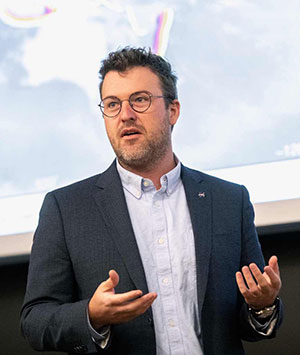
Understanding and predicting the global environment are critical to inform decisions across infrastructure, energy and agriculture. To understand and predict the global environment, global models are needed.
To better tackle this issue, Daniel McCoy, a University of Wyoming assistant professor of atmospheric science, is looking at Earth system models (ESMs) as the foundation of how to predict what Earth will look like in future decades.
McCoy received a U.S. Department of Energy (DOE) grant worth $998,587 over two years for his project titled “Creating the Framework for the Next-Generation Energy Exascale Earth System Model (E3SM) at PROCEED (Perturbed Physics Ensemble Regression Optimization Center for ESM Evaluation and Development).” The grant starts Sept. 1 and ends Aug. 31, 2025.
His is one of 14 clean-energy research projects that received $33 million in total funding from DOE in a July 26 announcement. This funding -- provided through DOE’s Established Program to Stimulate Competitive Research (EPSCoR) program -- is intended to improve geographic distribution of federal research and development funds and strengthen research capabilities in underserved regions of the country. The funded projects will cover a range of topics, including grid integration, renewable solar and wind energy, and advanced manufacturing.
McCoy explains that ESMs solve equations to predict winds, rain, clouds and temperature, among other quantities, in grid boxes all over the world. ESMs have been created by numerous different national and international laboratories, including DOE, with the goal of offering actionable projections of Earth system variability and change. Additionally, he says scientists are constantly developing, improving and challenging ESMs by comparing what they predict to what is seen from the surface, aircraft and satellites to make sure they can provide reliable predictions of the future.
“ESMs have a tough job. They need to be able to calculate how storm systems a thousand miles wide will deluge us with rain or batter us with wind. At the same time, droplets in clouds less than a millimeter in size form on little pieces of dust and grit,” McCoy says. “The way that droplets form in clouds affects the way that these storms develop. ESMs have to tackle both problems at the same time.”
McCoy is the principal investigator (PI) on the project and will collaborate with Jennifer Griswold, an associate professor of atmospheric sciences and department chair at the University of Hawaii-Mānoa. Gabrielle Allen, director of the UW School of Computing, and Dana Caulton, a UW assistant professor of atmospheric science, will serve as co-PIs on the grant.
The group will work with scientists at Pacific Northwest National Laboratory and Lawrence Livermore National Laboratory. Additionally, the grant will have an external advisory panel, including scientists at the U.K. Meteorological Office, Scripps Institution of Oceanography at the University of California-San Diego, NASA Goddard Institute for Space Studies and Delft University of Technology.
“The National Science Foundation-funded Derecho supercomputer at the NCAR-Wyoming Supercomputing Center that the state of Wyoming has significantly invested in is making this kind of computational work possible,” McCoy says. “One of the main components of this work is using artificial intelligence and machine-learning techniques to make the way that we develop new ESMs more efficient and reliable. At the University of Wyoming, the scientists who are participating in PROCEED are drawn from the Department of Atmospheric Science and the School of Computing.”
PROCEED will develop new approaches to improve the way processes on the scale of dust and cloud droplets in ESMs are represented and to better understand how they imprint on our planet, he says.
“America’s next big energy breakthrough can come from anywhere in the nation, and that’s why federal research and development investments should reach and benefit all parts of the country,” Secretary of Energy Jennifer Granholm says. “The funding we’re announcing today will spur innovation and create energy jobs around the nation.”

